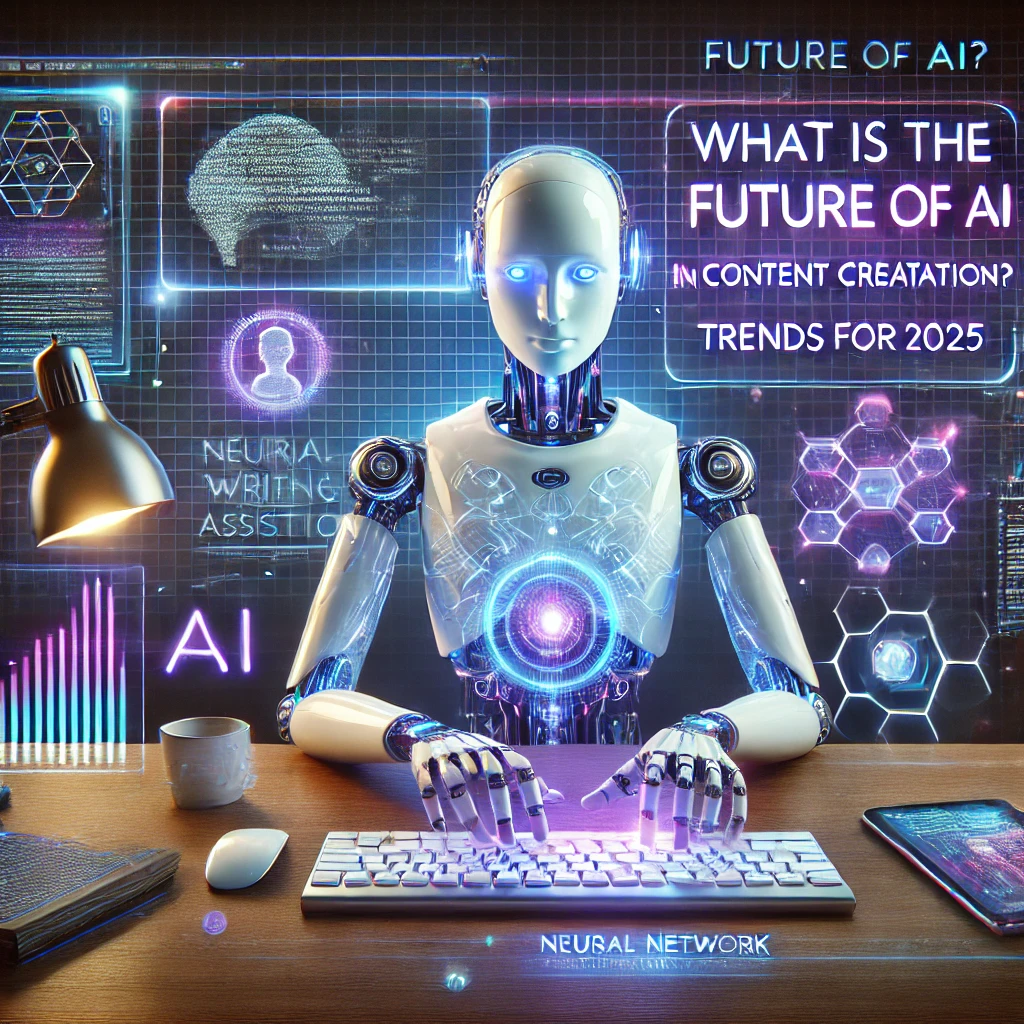What Is the Future of AI in Content Creation? Trends for 2025
Curiosity about the future of AI in content creation sparked my journey into a world where technology meets imagination, and I couldn’t wait to share what I discovered.
As I observed a passionate expert dive into this topic, I realized how vital high-quality content remains for small business owners, bloggers, and entrepreneurs eager to draw in leads.
This exploration unveiled a treasure trove of AI tools designed to craft both long-form articles and snappy social media posts with ease.
The person I watched wielded these tools like a seasoned artist, showing me how they streamline workflows while boosting visibility through search engine optimization.
By March 06, 2025, these innovations promise to reshape how we think about creating and sharing ideas online.
What struck me most was the seamless blend of automation and creativity, proving that artificial intelligence isn’t here to replace us but to amplify our voices.
Tools like ContentShake AI and Social Content AI, both powered by Semrush, stood out as game-changers, and I’m excited to walk you through what I learned.
Join me as I unpack these trends, offering a front-row seat to a masterclass in leveraging AI for content that captivates and converts.
We strongly recommend that you check out our guide on how to take advantage of AI in today’s passive income economy.
Table of Contents
AI-Generated Content
Crafting Long-Form Magic with ContentShake AI
As I sat back and observed, the expert logged into their Semrush account, navigating straight to a tool called ContentShake AI, a powerhouse for generating long-form content.
They began by explaining how this tool taps into Semrush’s vast SEO database, pulling real-time insights to optimize articles for search engines right from the start.
I marveled at how they entered a simple keyword like “AI tools for local small businesses” and watched the platform spring to life, suggesting topics and analyzing competitors in seconds.
The interface glowed with options—article optimization, idea generation, and even tone adjustments—making it clear this wasn’t just another basic writing assistant.
What really caught my eye was how they set up a brand voice by pasting a sample blog post, letting the AI learn their style and adapt it for future pieces.
Within moments, a “Digital Guru” voice emerged—informal yet expert-driven—perfectly tailored to their audience of no-code enthusiasts and business owners.
They hit “generate article,” and I watched in awe as a 3,000-word piece materialized, complete with targeted keywords and a structure ready to rank on Google.
This wasn’t just AI-generated content; it was a polished draft that felt human, proving the future of AI in content creation lies in collaboration, not replacement.
Fine-Tuning for Perfection
The expert didn’t stop there—they dove into the editor, showing me how to tweak this AI-generated content with precision.
I noticed a toolbar packed with features: generating new titles, rewriting sections, and even pulling competitor data to refine the piece further.
They clicked “generate titles,” and a list of catchy options popped up, each one sharper than the last, like “AI Tools Every Small Business Needs Now.”
I could see the gears turning as they adjusted the tone from casual to formal, imagining how this flexibility could suit different niches, from tech startups to lifestyle blogs.
The SEO boost feature grabbed my attention next—adding relevant keywords and Unsplash images to elevate the article’s appeal and ranking potential.
They emphasized how this real-time customization ensures the content aligns with 2025’s demand for relevance and engagement.
By the time they hit “publish,” connecting it straight to WordPress, I realized this tool cuts hours of work into minutes without sacrificing quality.
The future of AI in content creation, I learned, thrives on this ability to refine raw output into something uniquely yours.
AI Writing Tools
Why ContentShake AI Stands Out
Reflecting on what I’d seen, I understood why the expert favored ContentShake AI over older tools like ChatGPT for their writing needs.
They pointed out how earlier AI writing tools often churned out generic, uninspired text that needed heavy editing to shine.
In contrast, ContentShake AI felt like a partner, offering suggestions grounded in SEO data and competitor analysis from the get-go.
I watched them explore the idea generator, typing “AI models” and grinning as high-traffic topics like “AI Ecosystem Efficiency” appeared instantly.
The tool’s integration with WordPress and browser extensions made it a one-stop shop, a stark upgrade from the fragmented workflows I’d known before.
They highlighted how 2025 will demand tools that don’t just write but strategize, and this one delivered with its real-time SERP analysis.
I couldn’t help but feel excited about how AI writing tools like this empower creators to focus on ideas rather than mechanics.
The future of AI in content creation, they showed me, is about smarter systems that anticipate your goals and lighten the load.
Building a Consistent Brand Voice
One moment that stuck with me was when they customized their brand voice, a feature I hadn’t realized could be so transformative.
They explained how consistency in tone builds trust with readers, something AI writing tools are now mastering for 2025.
By uploading a sample, the AI dissected their style—playful yet knowledgeable—and applied it across every article.
I watched them tweak the audience settings, targeting startup founders and IT consultants, and the content shifted subtly to match.
The sample text with and without the brand voice side-by-side was a revelation; the tailored version felt alive, while the generic one fell flat.
They saved the settings, and I could see how this ensures every piece reflects their identity, no matter who’s reading.
This level of personalization, they noted, is where the future of AI in content creation will separate the pros from the amateurs.
It’s not just about writing—it’s about speaking directly to your tribe in a voice they recognize and trust.
Machine Learning in Media
Social Content AI’s Short-Form Power
Next, the expert pivoted to Social Content AI, another Semrush gem, and I leaned in to see how machine learning in media tackles short-form content.
They navigated to the social media tab, where a dashboard burst with ideas tailored to their no-code AI niche—posts about digital entrepreneurship and e-commerce.
I was impressed as they input their website domain, letting the tool crawl it and suggest topics based on existing content.
They clicked “generate content” and chose a blog post URL, crafting an X post with an inspiring tone that recapped the article in seconds.
The result—“Master no-code with confidence and build your first app!”—was punchy and perfect for grabbing attention.
Machine learning in media, I realized, shines here by analyzing trends and audience preferences to churn out posts that hit the mark.
They toggled the tone to humorous, and a witty version emerged, showing how versatile this tool is for 2025’s fast-paced platforms.
The future of AI in content creation isn’t just long articles—it’s snappy, targeted bites that keep followers engaged.
Visuals and Flexibility
What really blew me away was how they used Social Content AI to craft visuals, a nod to how machine learning in media will dominate 2025.
They selected “create visual,” picking dimensions like 1080×1920 for an Instagram story, and described a sleek “no-code tools” graphic.
The tool churned out a design—clean lines, bold text, vibrant colors—that I could envision popping on a phone screen.
They swapped it for a LinkedIn-friendly size, and the adaptability made me see how one tool can serve multiple platforms effortlessly.
I watched them generate a poll from an article about AI design tools, asking, “Which tool boosts your visuals most?” with trendy options.
The ability to add hashtags and schedule posts directly through Semrush felt like a time-saver creators will crave.
This fusion of text and imagery, powered by real-time data, showed me the future of AI in content creation is multimedia mastery.
It’s about meeting audiences where they are, with content that looks as good as it reads.
AI-Powered Marketing
SEO and Lead Generation in 2025
The expert’s focus on SEO through these tools opened my eyes to how AI-powered marketing will drive leads in 2025.
With ContentShake AI, they generated a 3,000-word article scoring 64% on Semrush’s SEO scale, primed to climb Google’s ranks.
I watched them review the competitor analysis, noting how the tool suggested keywords like “AI for entrepreneurs” to outpace rivals.
They explained how AI-powered marketing thrives on this data-driven edge, ensuring content doesn’t just exist—it performs.
The Social Content AI side tied in perfectly, turning long-form wins into short-form hooks that pull followers deeper into the funnel.
I could see small businesses using this to attract clients without breaking the bank on ads or agencies.
The future of AI in content creation, they proved, is about precision—reaching the right people with the right words at the right time.
It’s marketing that feels organic yet hits harder than ever, all thanks to AI’s analytical muscle.
Streamlined Publishing Power
One of the slickest moves I saw was how they published content with zero hassle, a testament to AI-powered marketing’s efficiency.
From ContentShake AI, they sent the article to Google Docs, preserving formatting for team edits, or straight to WordPress with a plugin.
I pictured a blogger hitting “publish” and sipping coffee while the tool handles the grunt work—no copying, pasting, or reformatting.
They shared a read-only link, imagining a client reviewing it, and I saw how this cuts collaboration time in half.
On the social side, they scheduled an X post directly through Semrush, syncing it with their campaign calendar.
This seamless flow from creation to distribution felt like the future of AI in content creation unfolding before my eyes.
It’s not just about making content—it’s about getting it out there fast, flawlessly, and with impact.
In 2025, I learned, AI-powered marketing will turn creators into strategists, not just writers.
GPT Models
Beyond ChatGPT with Advanced AI
The expert’s casual dismissal of ChatGPT intrigued me, so I pressed them on how GPT models fit into 2025’s content landscape.
They admitted early GPT models were a starting point but lacked the depth and SEO smarts of tools like ContentShake AI.
I watched them compare outputs—ChatGPT’s bland paragraphs versus ContentShake’s keyword-rich, structured drafts—and the difference was night and day.
They explained how modern GPT models, embedded in these platforms, evolve with machine learning to prioritize user intent over generic text.
The future of AI in content creation, they argued, leans on these advanced iterations that blend creativity with strategy.
I saw this in action as Social Content AI repurposed a blog into a story post, using GPT-like logic to distill key points.
It’s not about replacing GPT models but supercharging them with real-time data and purpose-built features.
By 2025, I realized, content creation will hinge on AI that thinks like a marketer, not just a writer.
The Free Trial Advantage
What sealed the deal for me was when they mentioned both tools offer free trials, a nod to how GPT models democratize access.
They urged me to test ContentShake AI’s long-form prowess and Social Content AI’s social magic without spending a dime upfront.
I imagined myself exploring the idea generator, tweaking brand voices, and posting to X—all risk-free.
This accessibility, they noted, ensures creators of all levels can tap into the future of AI in content creation.
The trials let you feel the power of advanced GPT models paired with Semrush’s data, a combo that’s tough to beat.
They grinned, saying it’s like test-driving a sports car—you’ll know within minutes if it’s your ride.
I left convinced that 2025 will reward those who experiment with these tools early and often.
It’s an invitation to join the AI revolution, one free click at a time.
Conclusion
Stepping back from this deep dive, I felt a rush of optimism about the future of AI in content creation and its 2025 trajectory.
The expert’s hands-on demo of ContentShake AI and Social Content AI revealed a world where long-form and short-form content coexist in harmony.
I saw how AI-generated content can be polished into SEO gold, how AI writing tools save time while boosting quality, and how machine learning in media crafts visuals that pop.
The AI-powered marketing edge they showcased—tying creation to distribution—felt like a blueprint for success in a crowded digital space.
Even GPT models, once standalone stars, now play a supporting role in smarter, more integrated systems.
What I learned most is that the future of AI in content creation isn’t about machines taking over—it’s about empowering us to shine brighter.
These tools, available to anyone willing to try, promise to level up creators, from bloggers to YouTubers, in ways we’re just beginning to grasp.
As I wrapped up my observation, I knew one thing for sure: 2025 will be the year AI turns content into connection, and I can’t wait to see it unfold.

We strongly recommend that you check out our guide on how to take advantage of AI in today’s passive income economy.




